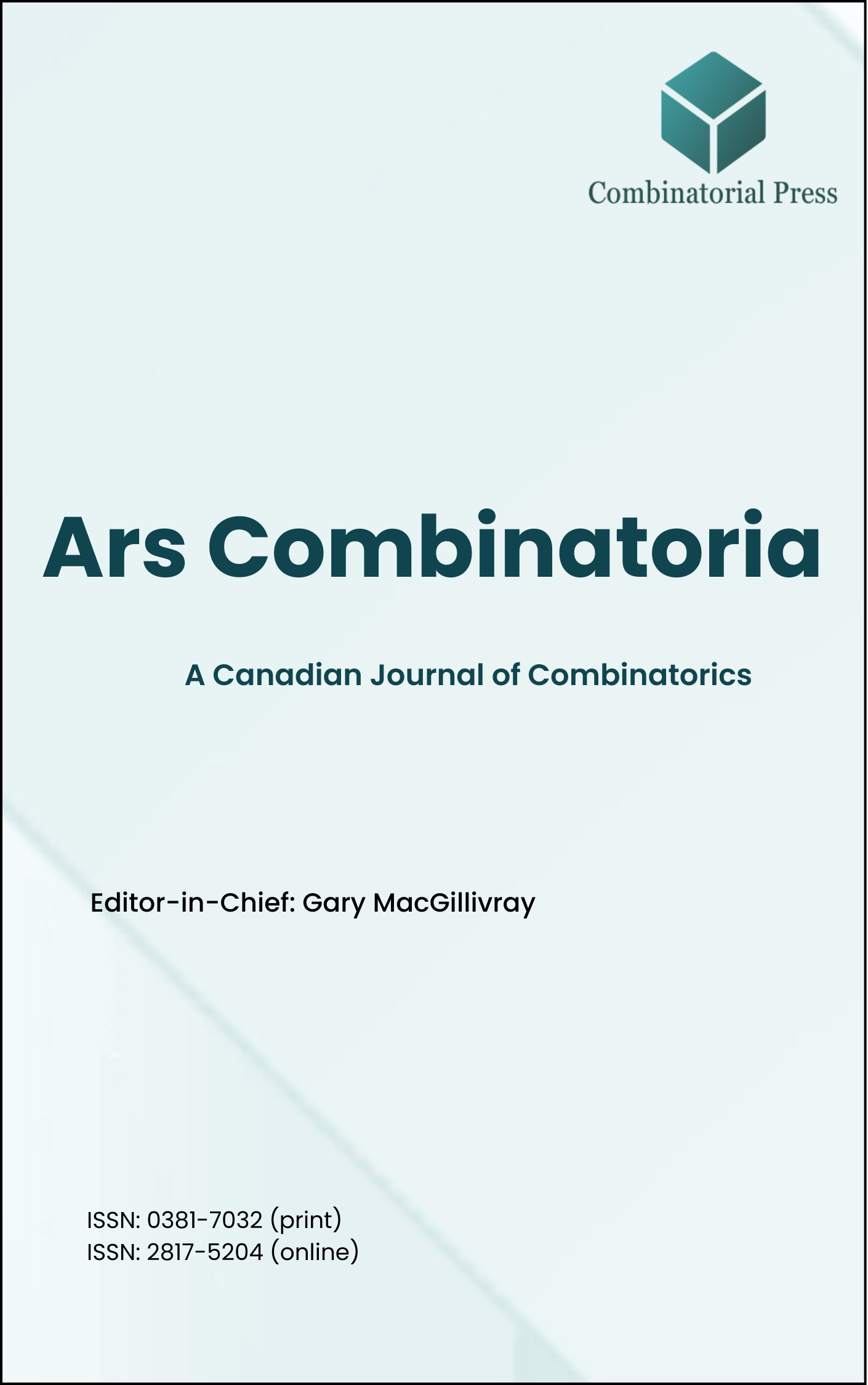
Ars Combinatoria
ISSN 0381-7032 (print), 2817-5204 (online)
Ars Combinatoria is the oldest Canadian Journal of Combinatorics, established in 1976. The journal is dedicated to advancing the field of combinatorial mathematics through the publication of high-quality research papers. From 2024 onward, it publishes four volumes per year in March, June, September and December. Ars Combinatoria has gained recognition and visibility in the academic community and is indexed in renowned databases such as MathSciNet, Zentralblatt, and Scopus. The Scope of the journal includes Graph theory, Design theory, Extremal combinatorics, Enumeration, Algebraic combinatorics, Combinatorial optimization, Ramsey theory, Automorphism groups, Coding theory, Finite geometries, Chemical graph theory but not limited.
Information Menu
- Research article
- Full Text
- Ars Combinatoria
- Volume 099
- Pages: 175-192
- Published: 30/04/2011
In this paper, we characterize the potentially \((K_5 – C_4)\)-graphic sequences, where \(K_s – C_4\) is the graph obtained from \(K_5\) by removing four edges of a \(4\)-cycle \(C_4\). This characterization implies a theorem due to Lai \([6]\).
- Research article
- Full Text
- Ars Combinatoria
- Volume 099
- Pages: 161-173
- Published: 30/04/2011
A graph is said to be cordial if it has a \(0-1\) labeling that satisfies certain properties. The purpose of this paper is to generalize some known theorems and results of cordial graphs. Specifically, we show that certain combinations of paths, cycles, stars, and null graphs are cordial. Finally, we prove that the torus grids are cordial if and only if its size is not congruent to \(2\) \((mod 4)\).
- Research article
- Full Text
- Ars Combinatoria
- Volume 099
- Pages: 149-160
- Published: 30/04/2011
A graph \(G\) is edge-magic if there exists a bijection \(f\) from \(V(G) \cup E(G)\) to \(\{1, 2, 3, \ldots, |V(G)| + |E(G)|\}\) such that for any edge \(uv\) of \(G\), \(f(u) + f(uv) + f(v)\) is constant. Moreover, \(G\) is super edge-magic if \(V(G)\) receives \(\{1, 2, \ldots, |V(G)|\}\) smallest labels. In this paper, we propose methods for constructing new (super) edge-magic graphs from some old ones by adding some new pendant edges.
- Research article
- Full Text
- Ars Combinatoria
- Volume 099
- Pages: 139-147
- Published: 30/04/2011
In this study, we consider a generalization of the well-known Fibonacci and Lucas numbers related to combinatorial sums by using finite differences. To write generalized Fibonacci and Lucas sequences in a new direct way, we investigate some new properties of these numbers.
- Research article
- Full Text
- Ars Combinatoria
- Volume 099
- Pages: 129-138
- Published: 30/04/2011
A graph \(G\) is called edge-magic if there exists a bijective function \(\phi: V(G) \cup E(G) \rightarrow \{1, 2, \ldots, |V(G)| + |E(G)|\}\) such that \(\phi(x) + \phi(xy) + f\phi(y) = c(\phi)\) is a constant for every edge \(xy \in E(G)\), called the valence of \(\phi\). A graph \(G\) is said to be super edge-magic if \(\phi(V(G)) = \{1, 2, \ldots, |V(G)|\}\). The super edge-magic deficiency, denoted by \(\mu_s(G)\), is the minimum nonnegative integer \(n\) such that \(G \cup nK_1\) has a super edge-magic labeling, if such integer does not exist we define \(\mu_s(G)\) to be \(+\infty\). In this paper, we study the super edge-magic deficiency of some families of unicyclic graphs.
- Research article
- Full Text
- Ars Combinatoria
- Volume 099
- Pages: 109-128
- Published: 30/04/2011
In \([FP]\) the \(ECO\) methed and Aigner’s theory of Catalan-like numbers are compared, showing that it is often possible to translate a combinatorial situation from one theory into the other by means of a standard change of basis in a suitable vector space. In the present work we emphasize the soundness of such an approach by finding some applications suggested by the above mentioned translation. More precisely, we describe a presumably new bijection between two classes of lattice paths and we give a combinatorial interpretation to an integer sequence not appearing in \([SI]\).
- Research article
- Full Text
- Ars Combinatoria
- Volume 099
- Pages: 97-107
- Published: 30/04/2011
High stopping-distance low-density parity-check \((LDPC)\) product codes with finite geometry \(LDPC\) and Hamming codes as the constituent codes are constructed. These codes have high stopping distance compared to some well-known LDPC codes. As examples, linear \((511, 180, 30)\), \((945, 407, 27)\), \((2263, 1170, 30)\), and \((4095, 2101, 54)\) LDPC codes are designed with stopping distances \(30\), \(27\), \(30\), and \(54\), respectively. Due to their good stopping redundancy, they can be considered as low-complexity codes with very good performance when iterative decoding algorithms are used.
- Research article
- Full Text
- Ars Combinatoria
- Volume 099
- Pages: 89-95
- Published: 30/04/2011
The basis number of a graph \(G\) is defined to be the least positive integer \(d\) such that \(G\) has a \(d\)-fold basis for the cycle space of \(G\).
In this paper, we prove that the basis number of the Cartesian product of different ladders is exactly \(4\). However, if we apply Theorem \(4.1\) of Ali and Marougi \([4]\), which is stated in the introduction as Theorem \(1.1\), we find that the basis number of the circular and Möbius ladders with circular ladders and Möbius ladders is less than or equal to \(5\), and the basis number of ladders with circular ladders and circular ladders with circular ladders is at most \(4\).
- Research article
- Full Text
- Ars Combinatoria
- Volume 099
- Pages: 83-87
- Published: 30/04/2011
It is shown that there are \(\binom{2n-r-1}{n-r}\) noncrossing partitions of an \(n\)-set together with a distinguished block of size \(r\), and \(\binom{n}{k-1}\binom{n-r-1}{k-2}\) of these have \(k\) blocks, generalizing a result of Béna on partitions with one crossing. Furthermore, specializing natural \(q\)-analogues of these formulae with \(q\) equal to certain \(d^{th}\) roots of unity gives the number of such objects having \(d\)-fold rotational symmetry.
- Research article
- Full Text
- Ars Combinatoria
- Volume 099
- Pages: 75-82
- Published: 30/04/2011
In this paper, we introduce the concept of geodesic graph at a vertex of a connected graph and investigate its properties. We determine the bounds for the number of edges of the geodesic graph. We prove that an edge of a graph is a cut edge if and only if it is a cut edge of each of its geodesic graphs. Also, we characterize a bipartite graph as well as a geodetic graph in terms of its geodesic graph.





